The way many begin hunting is usually with a gun, but for those of you who wish to use a bow, you are at the right place as we go on to explaining how to make a hunting bow. Whilst the majority of hunter discover the enjoyment of hunting and enhance their skills, they usually look for a variety of ways to recall the early excitement. Bow hunting is a brilliant way to challenge yourself, as this is experience is really different to hunting with a gun.
[the_ad_placement id=”in-text-1-type-r”]Many hunters rapidly find their thrill especially when they go through the experience of being so close to their prey using a weapon that is silent. Whether hunting is your true passion or just something you prefer for those boring days, you must be familiar with building your very own equipment.
Importance of creating your own hunting bow
As you may know hunting is one of the most popular activities for people of all ages, races, and backgrounds. If you want to know how to hunt, you first of all must be familiar with the tools for the trade. The most popular tools used for hunting are a bow and an arrow. You may have come in touch with such equipment in general and sporting stores, which may seem a little expensive.
Alternatively, even if you do not visit such stores, you may be stranded on a desert or merely in your back garden with the passion of creating your very own hunting bow and arrow. The good news is you can do this with a relatively small amount of bucks and some spare time on your hands.
Making a hunting bow
Making your very own hunting bow is a lot less difficult than what you may expect. There is no need for you to be an expert or a master with DIY in order to create a functional hunting bow you can use for recreation and hunting purposes.
When starting, you need to consider the different types of wood, which are:
- Yew
- Bamboo
- Willow
- Lemon
All of these woods are perfect to use for a hunting bow and you need to ensure the one you choose, measures roughly a yard in length. This must be free of any coils or knots. A recommending tip is to make sure the wood is dry, but not so much that it reaches cracking point once bent. An important tool you will need for the entire process is a knife, which is sharp. Be sure to sharpen that pocket knife before commencing the project.
The first step to make a hunting bow is to begin with the natural curve of the wood. All piece of wood have this, but it may be easier to spot on some than on others. This is the most important bit as you don’t want to be carving it on the wrong side. If you do this, the bow will snap within the first use.
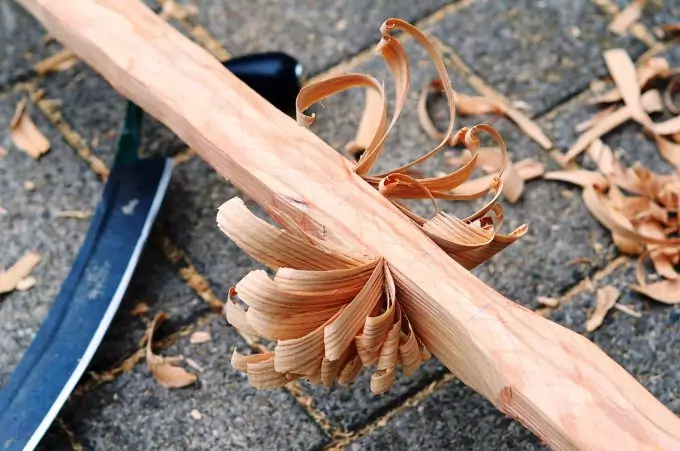
Once you have distinguished the curve, you need to carve the wood into a shape similar to a boomerang. The middle should be fairly larger than the ends of the stick. E.g.) it the middle’s thickness is one inches, then both of the ends need to be close to ¾ of an inch. In order to assure the duration of your bow, it is best to wrap a tight strip of wet leather around the centre and let this dry in natural form. Due to this, the bow will receive its additional sturdiness and will also push arrows at a superior speed.
[the_ad_placement id=”in-text-2-type-r”]Once the shape has been carved, you need to tie the string. There are a variety of strings you can use for this purpose, such as:
- Hemp
- Fish line
- Linen
- Nylon
- Dacron
- Kevlar
Once you have selected the string you wish to use, it is required you wax this in order to promote durability and to provide protection against natural wear and tear. You then need to carve a cut towards the ends of the bow and ring the string around both ends. Your string needs to have a taut appearance, and not one that appear loose and floppy.
The hunting arrow
That’s it, or is it? Well it is called a hunting bow, so what happened to the boy? Our hunters bow is nothing without arrows, which is why you need to make the arrows that will fit inside the bow. These shouldn’t be too long as they will break. The arrows can be long sticks as it is both of the ends, which causes them to fly.
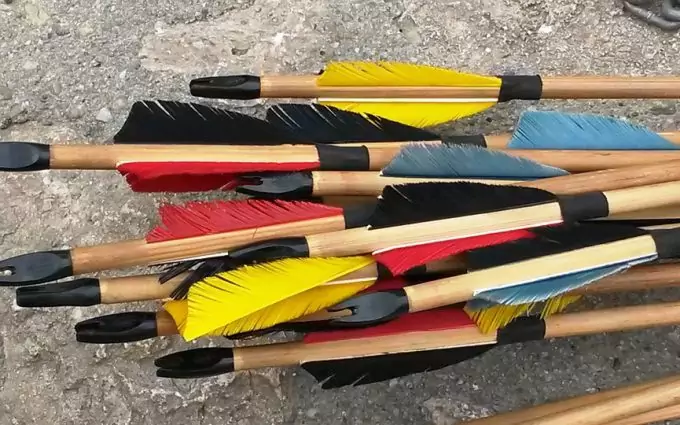
One of the ends needs to be facing out, which will be fitted with a steel arrowhead. In order for your arrows to have an optimal flying experience, you can always attach a couple of feathers towards the end that is closer to you.
Still, if you decide to go pro and want to try arrows specially created for hunters by specialists, take a look at our article on the best arrows for hunting.
Creating a hunting bow in your backyard
If you wish to make your hunting bow in your backyard, all you need is the following:
- Machete
- Hand axe
- Draw knife
- Rat tail file
- Wood rasp
- Tape measure
- Carpenters pencil
- Straight edge
- Bow string
If you have the tools listed above you can begin the method of building a bow. The list above is a bare bones list and if you have additional power tools you feel comfortable using, then you can do this by all means.
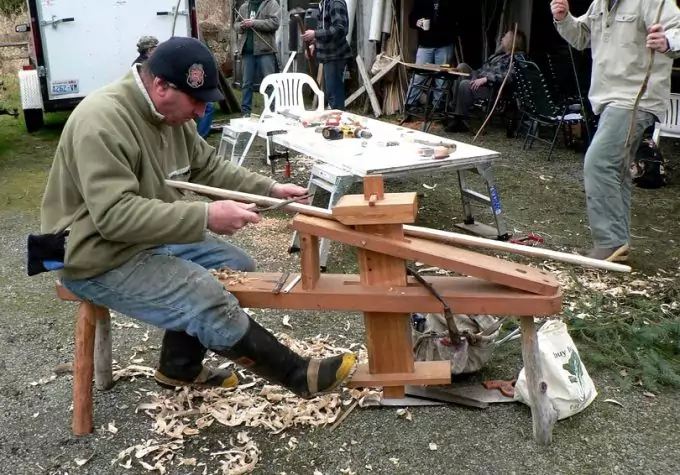
Listed below are the steps of making a hunting bow in the comfort of your back garden:
- First of all, you need to select a tree. The majority of woods will work, but those with a slippery bark hickory works the best for a fantastic first time bow. The tree you select must be four inches in diameter straight with a couple of knots. You can then cut the tree down and cut the straight section six feet long. You must let this season for about six months.
- After six months have passed, you can then peel off the bark using a draw knife. You need to choose the side that is the straightest and cleanest to lay your bow out on, using the pencil. The layout should be similar to the following: 4” handle section in the centre and 68” long. For the hickory, you must leave the limb wide or make this one and ¾” wide.
- The machete and hatchet should be used to cut away wood that is not needed. The wood rasp may also be used for adding fineness for your work. Once the profile is cut-out, you then have to thin the limbs down. These need to be marked out so they are ½” thick than their complete length. The handle section must be left 2” thick. Again, the axe, machete, and wood rasp must be used to shape the limbs.
- After the rough shaping is done you need to place one bow limb towards the floor and press against the handle. You need to look accurately to see whether the limb bends consistently. This process should be repeated with the opposite limb.
- Finally, when both limbs are equally bending, you can use the rat file in order to cut the notches towards the tips in both limbs. This is the nock. You should attach the string to both nocks and look at this from the side. The limbs need to bend in an even manner towards a near semi-circle. If this is not what you see, then you need to scrape the wood from the harder limb. You should continue to do this until the limbs bend in an even manner looking like a semi-circle when threaded.
How to make an arrow for a hunting bow
Now that you have made your hunting bow, it is time to move on to the arrow, as a bow is incomplete without an arrow! Making wooden arrows with a traditional-style is an effective and easy procedure. Before modern arrows came into practice, accurate arrows were made using readily available materials.
Once upon a time, famous characters like Robin Hood were even found creating their own arrows from natural materials found in the growing forest. You can make wooden arrows by following the simple steps below with the need of using only basic tools, patience, and a little time, which will lead to an amazing tremor of homemade arrows.
The things you will need for this are:
- String
- 30” tall straight wood sprigs
- Knife
- Feathers
Firstly, you need to choose and cut a young sprig without any knots or branches with a straight section of roughly 30”. Then you need to use the knife in order to create a point on the end of the arrow shaft. After that you need to notch the other end of the arrow shaft using a knife; allowing the arrow to come into contact with the bowstring. And lastly, you need to cut three bird feathers down the center following the spike. The three half feathers need to be attached to the arrow shaft near the end that is notched. These need to be spaced evenly around the arrow with the string.
Making feathers for the hunting arrow
Making arrows for the hunting bow is an important factor to consider as these help the arrow stay in the right direction and move with extreme speed in the direction you shoot. Feathers are used on the base of an arrow in order to make is spin during flight; making it more accurate. If you are able to use bird feathers or have extra feathers, then you can use these. Alternatively, if you do not have these, then you can use heavy paper (card) for this. You may also use plastic as an alternative to paper – card.
[the_ad_placement id=”in-text-3-type-r”]You need to take the material you are using and cut triangles out of it. The triangle should feature legs about one and a ¼” by one three fourths inches (the legs refer to the triangle, those that aren’t opposite the right triangle). You need to glue these triangles to the base of the arrow, taking the second longest side near the base roughly an inch away from the bottom.
The triangles must be spaced out evenly around the border of the arrow. You then need to cut a little nick into the center of the base of the bow where the string sits into. Without this nick, it would be difficult to shoot the arrow.
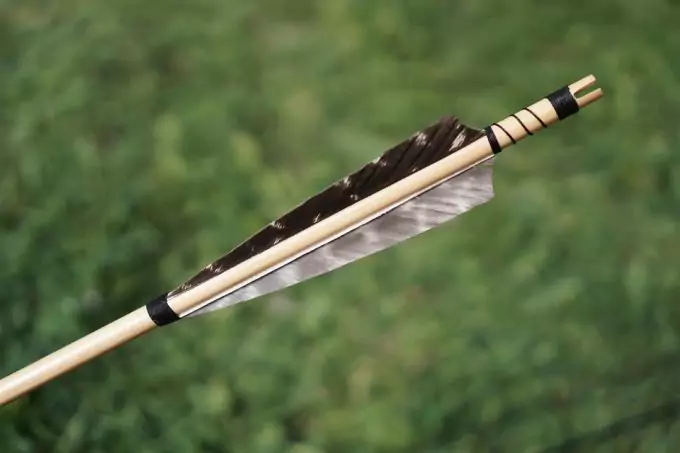
Follow this simple procedure and there is no reason to why you cannot become an expert with creating the hunting bow.
Still, now that you’ve become an expert in building a bow, you may need some tips to help you hunting with the tool you created. If so, we have a great set of tips and tricks for bow hunting that you should know.
The bottom line
Now that you know how to create your very own hunting bow, it is time to get started. You surely need to get that practice in and get out there in order to experience everything for real. So, if you’re not familiar with the practice, take a look at our tutorial on how to shoot a bow and arrow and learn it step-by-step.
Have a brilliant hunting experience and encourage your family and friends – who also love the sport, to do the same!
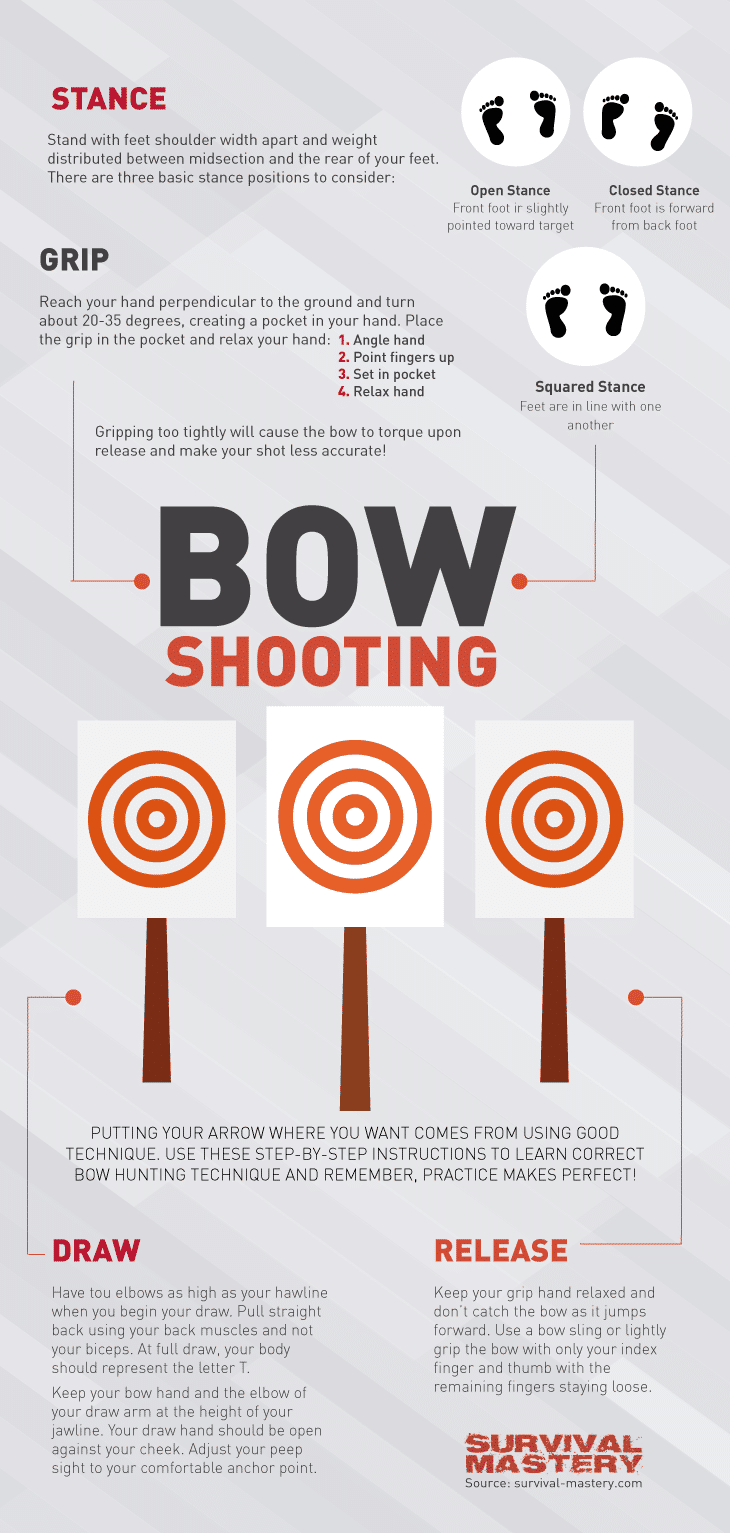
Every hunter needs to make their own tackle because if he is unable to make or repair it, he will be unable to shoot for long. Even though target arrows, bows, and feathers can be brought in sporting stores, a true hunter must know how to make their very own bow and arrow. The truth behind manufacturing your very own bow and arrow is the fact that you appreciate them more this way.
However, it does take many attempts before creating the perfect bow and arrow, but you must know that practice makes perfect. A beginner may find his first couple of bows will be failures, but it won’t be long until he is shooting them! You only realize the true dedication and passion behind hunting once you put in that time and effort to creating that bow and arrow. If it’s made by you, you will also respect it more, not forgetting to mention feel like a true professional at the same time.

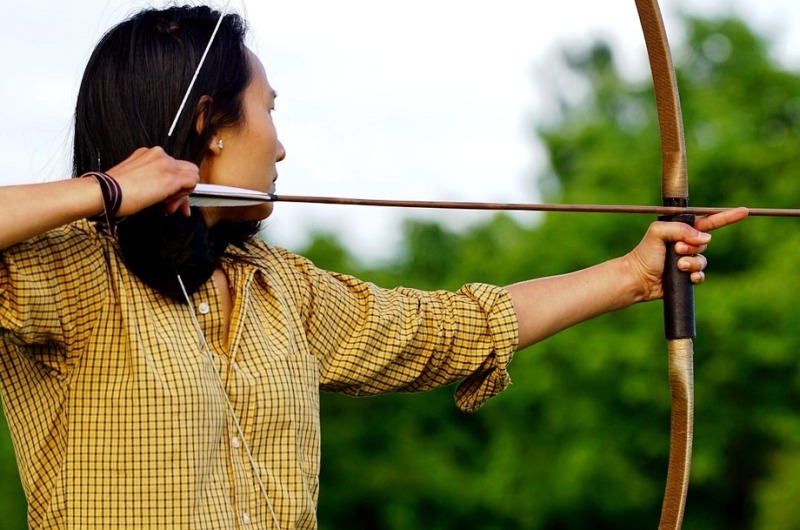

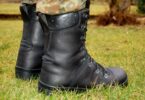


Can we really use bamboos for the bow? I think it will break just on the first use. But I really want to try hunting with a bow and arrow :D
The bamboo is one of the most flexible and resistant natural materials in the world so, yes, you can use it to make a bow. However, you must know how to choose the right length, width and state of the bamboo to avoid any accidents.
Bamboo has been used for over the years to make fine bows. It is tough, straight grained, very flexible, and easy to work. It is used for backing on many traditional laminated bows. This bow is neither fine, nor traditional, nor laminated; but it is quick and easy to make.
Just a few more tips to add: Used seasoned wood or wood that has been dried and stored in a cool, dry place for at least six months. Some insist on using wood that has been seasoned for at least one full year. Also read more about adding sinew-backing on your bow (deer backstrap sinew, deer leg sinew, and etc.) to improve performance, durability, and prevent breakage.
Most people prefer hickory or yew for bow making. Between the two, a yew bow is known to hold greater depth and is capable of storing more energy. Experts suggest that yew is the best for longbows.
You can make the best hunting bow by learning the basics, and have the correct material and tools.
Wood is a preference, but good results are obtained when working with complex materials that are formed by gluing together layers of various woods. Straight grained hardwood board is good to start with, but knowing what constitutes straight grain comes with experience, an easy way to tell is by looking at how growth rings run up the board.
When making a bow, keep in mind how strong you are. Training your triceps, shoulder, and upper back muscles can help you gain necessary strength. Also, while you do need to be strong to draw a bow, being stronger will not always affect the power of a shot past a certain point. Furthermore, technique and dexterity will affect your aim.
You can also choose vanes instead of feathers, they’re cheaper, more durable and water proof. Larger vanes will stabilize an arrow more, but they can also lead to dragging. It’s true that when choosing between feathers and vanes you would look for something more traditional, and more flexible, feathers fit perfectly here. In the end, it’s a matter of preference.
Arrows are a fundamental part of archery, they work hand in hand with the bow. The arrow has to match your bow’s strength, if the shaft is too stiff or too soft it will make the arrow hit your bow instead of leaving it effortlessly. Generally speaking, an arrow’s weight consists mostly of the shaft and point.
Your knowledge of an arrow’s anatomy is good. I will advise you to learn more on how to make a bow, you never know when you will need it in the wild. The provided tips are easy to follow. I do recommend a bamboo bow, it’s quite strong.
When making your own arrows, I would recommend vanes instead of feathers, because vanes are made from plastic and they can withstand humid and rainy conditions.
Shooting a bow and arrow is a technique that is learnt over time with practice, of course. However, you need to make a near-perfect bow that will actually shoot arrows with near-perfect accuracy.
Wood works best for beginners. In actual fact, wood offers you the easiest way of learning how to make a bow. You can make as many as you can until you master the skill.
I am always fascinated about bow hunting, and I try to find time to read bow hunting articles. One of the articles I have read talks about the two styles of bows that can be done in less than an hour; not just that, it is made out of right materials. One of those styles is panda bow that is made out of bamboo. It truly bends with a proper arc. No wonder it works best in hunting.
I will be going out with my cousins for hunting. It has been the tradition of the family that young ones, regardless of gender, must learn how to hunt. They have been telling me that guns are the best, but my archery skills would always look for bows and arrows. Since it would be my first time, I wanted to know whether the impacts of using gun or bow are the same.
If you were in the wilderness without any access to bow making tools, would it be possible to make one? Since it has been mentioned in numerous blogs and articles that bows are effective tool for hunting, are there materials and tools accessible for a hunter to use in no time to create one? If there are, what are those?
Bows and arrows are ultimate partners in hunting. Moreover, different hunters prove its pairing effective. Despite this idea, does a particular bow fit to all types of arrows? I am into working on making my own bow, but my dad has given me unique arrows ahead. I just do not know whether there is a standard in making one (like the type of arrows).
Usually, there are arrows for every type of bow. For instance, the arrows you shoot with a crossbow differ considerably from the arrows you shoot with a compound bow.
One of the most important tool that you need for making a survival bow is a knife. You can use the knife to shape a useful piece of wood into a primitive, but very handy survival bow and arrows for the given survival situation.
Usually, bow season is longer and more plentiful than gun season. Also, bow hunting strengthens different skills, it is quieter, and not bound by many legal concerns.
Personally, I learnt the skills of bow and arrow making when I was twelve. Depending on what you have in the field, you can come up with a primitive or a more advanced bow for your survival.